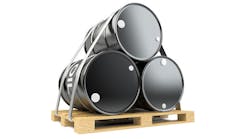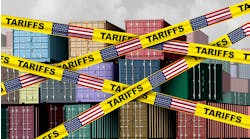On Dec. 18, 2015, President Obama signed a massive tax and spending bill that included a provision repealing the 40-year-old ban on U.S. crude oil exports. While the appropriations package made headlines for averting a government shutdown, it was a historic piece of legislation for U.S. energy firms.
The United States officially banned oil exports with the passage of the Energy Policy and Conservation Act of 1975 (EPCA)--a response to the 1973 OPEC oil embargo that sent gasoline prices skyrocketing, incited panic among American consumers, and highlighted the nation’s intensifying lust for energy and its precarious dependence on imported oil.
Signed into law by President Ford, EPCA also created the Strategic Petroleum Reserve--the world’s largest supply of emergency crude oil--as well as corporate average fuel economy (CAFE) standards for cars and trucks. While these and other EPCA provisions still are in place today, the domestic energy landscape has changed dramatically since the oil crisis of the 1970s.
Due to advances in hydraulic fracturing and directional drilling--often touted as the “shale revolution”--U.S. oil production is booming. According to the U.S. Energy Information Administration (EIA), the United States is the world’s largest producer of petroleum and natural gas hydrocarbons--which it attributes to the shale boom--and produced more than twice the petroleum and natural gas hydrocarbons than Saudi Arabia in 2015.
With this newfound capacity, U.S. energy firms wasted little time taking advantage of the repeal of the export ban. On Dec. 31, 2015, ConocoPhillips and NuStar Energy said they loaded the nation’s first export of U.S.-produced light crude oil since the ban was lifted on Dec. 18. A tanker carrying light sweet crude--which came via pipeline from the Eagle Ford Shale--departed from a NuStar-owned terminal in the Port of Corpus Christi (Texas) just before 4:30 p.m. that day, according to an article in the San Antonio Business Journal. Vitol, a Netherlands-based trading company, purchased the shipment.
NuStar says it has invested heavily in its operations in the Port of Corpus Christi, including spending $93 million to acquire a second terminal in 2016. The investments in additional storage space, automation technology and other assets have given the San Antonio-based pipeline and terminal operator “the ability to load export-size cargoes from its docks,” according to the company.
U.S. refiners have been upgrading and expanding their infrastructure as well, explains Alan Free, senior vice president at Chicago-based Argo Consulting.
“Most U.S. refineries were designed to process the heavier grades associated with imported oil, and we have seen new investments on the downstream end to expand flexibility to run multiple feedstocks,” Free says. “Those able to efficiently process lighter grades can now capture a competitive advantage from domestic upstream production.”
In the first five months of 2016, U.S. companies exported crude oil to 16 countries other than Canada (which has been exempted from the oil-export ban since 1985), averaging 501,000 barrels per day--9% higher than the full-year 2015 daily average. To put those numbers in perspective, U.S. exports rarely exceeded 100,000 barrels per day from 2000 to 2013, according to the EIA.
Reversal of Flows
The United States has been a net importer of energy since the 1950s, but the shale boom has turned the tide. While U.S. imports of crude oil and petroleum products such as gasoline and diesel fuel peaked at 13.7 million barrels per day in 2005, they’ve been declining steadily ever since. In 2015, domestic consumption of imported oil hit its lowest level since 1970, according to the EIA.
But oil only tells part of the story. Driven by the shale boom, the United States became a net exporter of propane in 2010, according to the EIA, and now is the world’s largest exporter of propane. Sometimes referred to as liquefied petroleum gas, or LPG, propane is a byproduct of natural gas processing and crude oil refining.
Free notes that increased production of shale oil and natural gas in the Marcellus and Utica regions has been the catalyst for a domestic surplus of propane, which has driven prices downward. With more than enough supply to meet domestic demand, U.S. energy firms increasingly have been eyeing opportunities in international markets.
“As a global low-cost propane producer pursuing international export markets [that are] growing faster than the domestic market at better prices than the domestic market, the U.S. has rapidly expanded an efficient infrastructure of pipelines, shipping terminals and tanker capacity,” Free says. In addition to those investments in infrastructure, the recent expansion of the Panama Canal has contributed to America’s “domestic export advantage” in propane, he says.
U.S. propane exports increased from 562,000 barrels per day in the first half of 2015 to 793,000 barrels per day in the same period of 2016, according to the EIA. Although U.S. propane exports initially went to nearby markets in Mexico, the Caribbean and South America, in recent years they’ve been reaching more distant markets. Asia and Oceania accounted for 94% of the export growth in the first half of 2016, with Japan importing the most U.S. propane during that period.
“If current pricing trends continue, growing petrochemical demand--especially in Asia--will be the primary market for further increases in U.S. propane exports,” the EIA says.
‘A Perfect Storm’ for LNG
Sometime this year, the United States will become a net exporter of liquefied natural gas (LNG), according to EIA projections. The agency expects overall U.S. energy exports to come into balance with energy imports sometime between 2020 and 2030.
“Even with big spending cuts and drilling activity at record lows, the U.S. is swimming in gas,” Naureen Malik wrote in a recent Bloomberg Businessweek article, “The U.S. Unleashes the Full Power of Shale.”
More and more of that natural gas is heading to Mexico in pipelines. U.S. pipeline exports of natural gas have doubled since 2009, according to the EIA, and the agency attributes nearly all of this growth to a surge in pipeline exports to Mexico. The EIA expects this trend to continue, at least in the short term, as Mexico’s natural gas production struggles to keep pace with its growing demand. Mexico’s energy ministry recently unveiled a five-year plan to expand the country’s pipeline network to accommodate the increase in natural gas imports from the United States.
Although the bulk of all U.S. natural gas exports flow to Mexico and Canada via pipeline, the newly expanded Panama Canal will make it easier for tankers to carry LNG to faraway markets such as Japan, South Korea, China and Taiwan--which, collectively, import nearly two-thirds of the world’s LNG.
The new locks in the canal can accommodate 90% of the world’s current LNG tankers with capacity up to 3.9 billion cubic feet, according to the EIA. Prior to the expansion, a mere 6% of the current global fleet--with capacities up to 0.7 billion cubic feet--could make it through the canal.
“The expansion has significant implications for LNG trade, reducing travel time and transportation costs for LNG shipments from the U.S. Gulf Coast to key markets in Asia and providing additional access to previously regionalized LNG markets,” the EIA said in June 2016.
The expansion of the Panama Canal is just one ingredient in a “perfect storm” for U.S. natural gas exports, Free says. He notes that the United States is blessed with “vast gas reserves and the technology to efficiently bring the product to market on a cost-advantaged basis, both domestically and internationally.”
“The U.S. is positioned to be a global leader for decades,” Free says.




